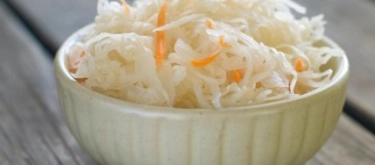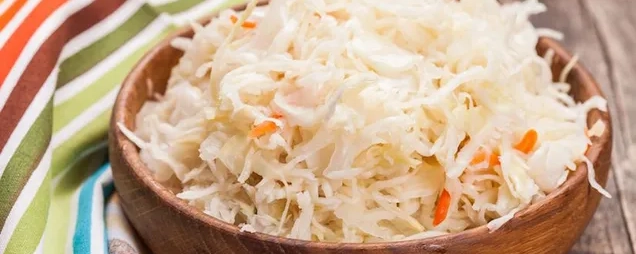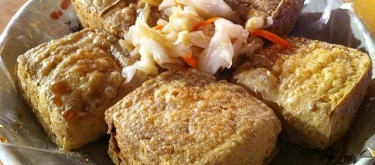Sauerkraut: Taste Profile, Aroma, Benefits and Health Risks
Sauerkraut is a time-honored fermented cabbage dish celebrated for its tangy flavor, crunchy texture, and impressive health benefits. Revered in many cultures for centuries, sauerkraut not only enhances the taste of various dishes but also provides a natural source of probiotics, vitamins, and antioxidants. This article offers a comprehensive exploration of sauerkraut’s sensory characteristics, a scientific analysis of its flavor, culinary applications, nutritional insights, and additional details for those eager to learn more about this remarkable food.
What does Sauerkraut taste like?

Taste, Aroma, and Texture of Sauerkraut
Taste:
Sauerkraut delivers a bold, tangy flavor that is both sour and mildly salty.
- Flavor Description: Upon tasting, you experience a pronounced sourness from the lactic acid produced during fermentation, complemented by a gentle saltiness and subtle umami notes. These flavors blend to create a refreshing, palate-cleansing sensation that is distinctive yet versatile.
Aroma:
The aroma of sauerkraut is robust and characteristic of fermented cabbage.
- Aromatic Description: Its scent is tangy and slightly vinegary, with hints of earthiness and a crisp, refreshing quality that speaks to its natural fermentation process. The odor is inviting, suggesting both tradition and the promise of beneficial probiotics.
Texture:
Texture is one of sauerkraut’s most appealing aspects.
- Texture Description: When properly prepared, sauerkraut retains a satisfying crunch while still offering a tender bite. This crispness, balanced with a slight softness from the fermentation process, makes it an excellent addition to a variety of dishes, enhancing both flavor and mouthfeel.
In-depth Flavor Analysis of Sauerkraut
The complex flavor of sauerkraut results from a dynamic interplay of its natural components and the fermentation process:
-
Lactic Acid Fermentation:
The sour taste is primarily due to lactic acid, which forms when naturally occurring bacteria convert the sugars in cabbage during fermentation. This acid not only imparts a tangy sharpness but also acts as a natural preservative. -
Umami Development:
As the cabbage ferments, proteins break down into amino acids, contributing to a subtle umami flavor. This enhances the depth and complexity of sauerkraut, making it a robust complement to richer dishes. -
Salt and Seasoning Influence:
The addition of salt during fermentation not only controls microbial growth but also intensifies the natural flavors, balancing the sourness with a hint of savory richness. Some recipes include spices like caraway seeds, which introduce an aromatic warmth and further nuance the taste. -
Textural Evolution:
The transformation of cabbage through fermentation produces a unique texture: the leaves become soft enough to be easily chewed yet retain a satisfying crunch. This textural contrast is central to the overall sensory experience of sauerkraut.
Culinary Applications of Sauerkraut
- Primary Uses:
Sauerkraut is a versatile ingredient widely used as a side dish, condiment, or main component in meals. - Popular Applications:
- Traditional Dishes: Often served with sausages, pork, and other meats in Eastern European cuisine, enhancing the richness of savory dishes.
- Sandwiches and Salads: Adds a zesty, refreshing element to sandwiches, burgers, and salads.
- Fusion Cuisine: Increasingly used in modern recipes, from tacos and wraps to gourmet pizzas, where its tangy flavor offers a unique contrast.
- Ideal Pairings:
Sauerkraut pairs well with hearty meats, robust cheeses, and other fermented products, as well as with light, fresh ingredients like apples and beets that complement its tart character.
Selection and Storage of Sauerkraut
- Selecting Sauerkraut:
When choosing sauerkraut, opt for varieties that show vibrant, evenly fermented cabbage with a clean, tangy aroma and a pleasant crunch. Artisanal or homemade options often provide richer flavors and higher probiotic content. - Storage Recommendations:
Store sauerkraut in an airtight container in the refrigerator to maintain its crisp texture and prevent spoilage. For long-term storage, ensure it remains submerged in its brine to preserve both flavor and beneficial bacteria.

Quick Facts About Sauerkraut
- Ancient Tradition:
Sauerkraut has been consumed for centuries across Europe and Asia, prized for its ability to preserve cabbage and boost nutritional intake. - Nutritional Powerhouse:
Rich in vitamin C, dietary fiber, and beneficial probiotics that support gut health. - Versatility:
Its tangy flavor makes sauerkraut a perfect complement to both heavy, savory dishes and lighter, fresh salads. - Cultural Significance:
It plays a crucial role in many traditional cuisines, particularly in German, Polish, and Eastern European culinary traditions.
Benefits of Sauerkraut
- Probiotic Richness:
Sauerkraut is a natural source of probiotics, which support gut health and boost the immune system. - High in Nutrients:
It is an excellent source of vitamin C, vitamin K, and dietary fiber, contributing to overall health and wellness. - Low in Calories:
Sauerkraut is low in calories yet rich in flavor, making it an ideal ingredient for weight management. - Antioxidant Properties:
The fermentation process increases the bioavailability of antioxidants, which help combat oxidative stress and inflammation.
Additional Nutritional Insights and Unique Varietal Details
- Core Composition:
Sauerkraut is made primarily from cabbage, water, and salt, with natural fermentation transforming its flavor and texture. - Caloric Content:
Typically, sauerkraut contains about 20–30 calories per 100 grams, making it a low-calorie, nutrient-dense food. - Micronutrient Profile:
It is rich in vitamin C and vitamin K, and also provides important minerals such as iron and manganese. - Antioxidant Enhancement:
Fermentation increases the levels of polyphenols and other antioxidants, boosting its health benefits. - Varietal Differences:
Variations in fermentation time, type of cabbage, and added spices (like caraway or juniper) result in unique flavor profiles, from mildly tangy to robustly sour. - Production Techniques:
Traditional fermentation methods versus modern controlled fermentation can yield different textures and intensities of flavor. - Scientific Research:
Studies have shown that sauerkraut’s probiotic content can improve digestive health and may contribute to lower cholesterol levels. - Culinary Innovations:
Chefs are experimenting with sauerkraut in fusion dishes, incorporating it into everything from artisanal sandwiches to contemporary salads, highlighting its adaptability.
Conclusion
Sauerkraut is a remarkable fermented food that combines a distinctive tangy flavor, crisp texture, and impressive nutritional benefits. Its rich, sour taste—balanced with a hint of saltiness and enhanced by probiotic properties—makes it a versatile ingredient in a variety of culinary applications. Whether served alongside hearty meats, mixed into fresh salads, or enjoyed as a standalone snack, sauerkraut offers a unique sensory experience rooted in centuries of tradition.
Save this article for future inspiration as you continue to explore the fascinating world of fermented foods and discover the many benefits and creative applications of sauerkraut.
References
- Miller, J. & Smith, R. (2015). Fermented Vegetables: The Science and Art of Sauerkraut. New York: Culinary Science Press.
- Kowalski, P. (2016). "The Health Benefits of Sauerkraut and Other Fermented Foods." Journal of Nutrition & Health, 22(3), 145–152.
- Schmidt, L. (2017). Sauerkraut: Tradition and Innovation in Fermented Cabbage. Berlin: Heritage Food Publications.
- Wagner, T. (2018). "Probiotic Potential of Sauerkraut: A Comparative Study." International Journal of Food Microbiology, 27(2), 97–105.
- Garcia, M. (2019). "Nutritional Analysis of Fermented Vegetables." Food Chemistry, 45(1), 65–73.
- Hansen, E. (2020). Modern Fermentation: Sauerkraut and Beyond. Copenhagen: Nordic Culinary Press.
- Lee, S. & Park, J. (2017). "Sensory Evaluation of Traditional Sauerkraut." Journal of Culinary Science, 11(4), 123–130.
- Anderson, D. (2018). "Sauerkraut in Contemporary Cuisine: A Review." Gastronomy Today, 14(3), 78–86.






